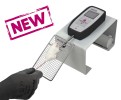Authors
M. Gasior, K. Soca_a, D. Nieoczym, P. Wla_.
Lab
Clinical Research, Cephalon, Inc., Frazer, USA.
Journal
Journal of Neural Transmission
Abstract
Clavulanic acid (CLAV) inhibits bacterial _-lactamases and is commonly used to aid antibiotic therapy. Prompted by the initial evidence suggestive of the potential anticonvulsant and neuroprotective properties of CLAV, the present study was undertaken to systematically evaluate its acute effects on seizure thresholds in seizure tests typically used in primary screening of potential antiepileptic drugs (AEDs). In the present study, 6-Hz seizure threshold, maximal electroshock seizure threshold (MEST) test, and intravenous pentylenetetrazole (i.v. PTZ) seizure tests were used to determine anticonvulsant effects of intraperitoneally (i.p.) administered CLAV in mice. Acute effects on motor coordination and muscle strength were assessed in the chimney and grip-strength tests, respectively. Doses of CLAV studied in the present study were either comparable or extended the doses reported in the literature to be effective against kainic acid-induced convulsions in mice or behaviorally active in rodents and monkeys. CLAV had no effect on seizure thresholds in the 6-Hz (64 ng/kg to 1 mg/kg) and MEST (64 ng/kg to 5 mg/kg) seizure tests. Similarly, CLAV had no effect on seizure thresholds for i.v. PTZ-induced myoclonic twitch, clonic convulsions, and tonic convulsions (64 ng/kg to 5 mg/kg). Finally, CLAV (64 ng/kg to 5 mg/kg) had no effect on the motor performance and muscle strength in the chimney and grip-strength tests, respectively. In summary, CLAV failed to affect seizure thresholds in three seizure tests in mice. Although the results of the present study do not support further development of CLAV as an AED, its beneficial effects in chronic epilepsy models warrant further evaluation owing to its, for example, potential neuroprotective properties.
BIOSEB Instruments Used:
Grip strength test (BIO-GS3)

 Pain - Thermal Allodynia / Hyperalgesia
Pain - Thermal Allodynia / Hyperalgesia Pain - Spontaneous Pain - Postural Deficit
Pain - Spontaneous Pain - Postural Deficit Pain - Mechanical Allodynia / Hyperalgesia
Pain - Mechanical Allodynia / Hyperalgesia Learning/Memory - Attention - Addiction
Learning/Memory - Attention - Addiction Physiology & Respiratory Research
Physiology & Respiratory Research
 Pain
Pain Metabolism
Metabolism Motor control
Motor control Neurodegeneration
Neurodegeneration Cross-disciplinary subjects
Cross-disciplinary subjects Muscular system
Muscular system General activity
General activity Mood Disorders
Mood Disorders Other disorders
Other disorders Joints
Joints Central Nervous System (CNS)
Central Nervous System (CNS) Sensory system
Sensory system
